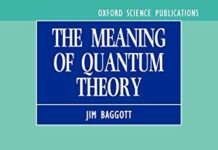
Ebook Info
- Published: 2018
- Number of pages: 421 pages
- Format: PDF
- File Size: 7.40 MB
- Authors: Jim Baggott
Description
What is life? Where do we come from and how did we evolve? What is the universe and how was it formed? What is the nature of the material world? How does it work? How and why do we think? What does it mean to be human? How do we know?There are many different versions of our creation story. This book tells the version according to modern science. It is a unique account, starting at the Big Bang and travelling right up to the emergence of humans as conscious intelligent beings, 13.8 billion years later. Chapter by chapter, it sets out the current state of scientific knowledge: the origins of space and time; energy, mass, and light; galaxies, stars, and our sun; the habitable earth, and complex life itself. Drawing togetherthe physical and biological sciences, Baggott recounts what we currently know of our history, highlighting the questions science has yet to answer.
User’s Reviews
Reviews from Amazon users which were colected at the time this book was published on the website:
⭐In the preface and in the book, Dr. Baggott emphasizes that his intent is to write a rigorous scientific account of human origins (a goal that I find very appealing). For the first seven chapters, which cover the origin and evolution of the universe and the solar system, he does an excellent job towards meeting his goal. The writing is clear and interesting, and the content is detailed and authoritative. His accounts of the interstellar molecular material and the evolution of the solar system are the best that I have read; indeed, it is rare to find any coverage of interstellar molecules in other books. These seven chapters are of five star quality.Unfortunately the remaining five chapters on the evolution of life are of a lower standard. They are, in general, much less detailed, patchy, and give the impression that the author is in a hurry. More troubling, Dr. Baggott sometimes indulges in speculative stories that fall short of scientific rigor. An early example is his notion of how the first living cells might have arisen in alkaline hydrothermal vents. The book ends with a lengthy chapter on human consciousness which is part philosophical and part speculative. Dr. Baggott believes that human consciousness, language, and artistic sensibility evolved 40,000 to 50,000 years ago, some 150,000 years after the appearance of our species, Homo sapiens. He does not explain how this happened. Although this hypothesis has not been shown to be incorrect, recent evidence from multiple sources has generally favored a much earlier development of consciousness and language. These sources include new sites of early representational art, indications of self-consciousness in non-human species, the discovery of the same FOXP2 allele in both the Homo sapiens and Neanderthal genomes, and recognition of artistic sensibility in incredibly beautiful hand axes which date back almost half a million years. Dr. Baggott’s emphasis on the sudden and recent emergence of consciousness ignores the alternative evidence.As an account of human origins, this book is incomplete, in my opinion. The hugely important migrations of Homo sapiens from Africa to all corners of the world are confined to three pages despite the large amount of detailed evidence that has been obtained from archaeological, genetic, and linguistic studies. The next important event in shaping who we are is the adoption of agriculture which in turn led to sedentary ways of life and the creation of ever larger societies, from villages to today’s near-global societies. These in turn were the incubators and users of new technologies that have had such an enormous impact on the human way of life and on the world in which we live. None of this is included in “Origins”.In an endnote to the Epilogue, Dr. Baggott refers to books on Big History including David Christian’s pioneering book “Maps of Time”, he claims that their coverage is less scientific than his. This is perhaps true. On the other hand, Dr. Baggott’s treatment of our origins is less complete: I suggest that you read both books!
⭐Excellent narrative and clear illustrations of creation from the big bang to us today and how we got here. The book goes into details of this complex process and the scientific rational for what has been observed. And it does this with clarity. The book is packed with understandable information and well worth the price. The index, notes and bibliography are complete and make it easy to find what you want in the book and find additional material to further your knowledge.
⭐It has a detailed picture of creation events.The creation of Helium, Lithium, Beryllium and heavier atoms are detailed. There is the production of stars, Super novas, Neutron stars, Population I and II and III stars.Types of galaxies, Dark Matter, Dark energy and a detailed description of many chemical compounds involved in life generation. Rna Dna and cellular structures are considered. All the eons from hadean to phanerozic are discussed. The progress of man over 200K years is covered. Finally the discussion of what it means to be human is discussed.
⭐I’m just past half-way in reading this book. It is very well written with no math to deal with or ignore. There are some chemical symbols, but understanding them is not critical to understanding the writing. All in all it is quite understandable and interesting. It reads almost like a novel, in that the author is telling a story, but with scientific explanations of how the story happens. I highly recommend it if you have an interest in how we came to be here in the universe.
⭐Interesting book. Most of this is over my head, but I wanted a more scientific approach to creation. Baggot provides good feedback for the science background and correlates to the religion beliefs. Great author, he states things as is and doesn’t fluff them up. The first few chapters are somewhat a struggle to get through, but it is all background and good information for creation and how things essentially began.
⭐Lots of good scientific journalism.
⭐Really quite good. Amazing depth for such a wide ranging survey of the current state of knowledge about human life’s origins and evolution. Baggot writes with absolute clarity, and clearly delineates between observed scientific fact and the speculation that must needs fill the gaps. If you’re not trained in the sciences, yet still want to come to a decent understanding of these matters, this book will suit you.
⭐To his credit, Baggott begins Chapter 1 with the disclaimer, “… be assured the nobody can tell you how the universe began. Or even if ‘began’ is a word that’s even remotely appropriate in this context.” Though Baggott does an interesting job of linking a broad range of empirical evidence and theories, he fails to address the problems of a) derivation of the “original mass” (Hawking’s “singularity),” and b) the mechanism of matter/energy moving from lower to higher complexity levels – Hawking’s posit that if a unified theory is in conflict with the Second Law of Thermodynamics, that would be bad for the theory. Explanation of “Agency” in such matters seems to be missing. Inasmuch as the standard definition of the word “creation” is “To bring into existence” and “The act of bringing something into existence that had not existed before (the creative action),” the author should have chosen a more appropriate subtitle.
⭐Really good account of creation as we understand it at the moment. The only slight problem for the layman is fully understanding the technical detail of what is written. If you stick at it it is well worth the effort.
⭐I haven’t read all of it yet but it is very well written by a very knowledgable writer.
⭐As described
⭐This is a unique book that explores the scientific perspective on Origins from the Big Bang, to galaxy and star formation, to the birth of the solar system, to the origin of the earth and moon, to the evolution of the physical planet, to the origin of life, to the evolution of cells and multicellular life, to the origin and evolution of human beings. The scope is vast and Mr. Baggott does an admirable, even unexcelled, job of bringing together the latest scientific perspectives on these topics. I am a professional (academic) geoscientist so I know quite a bit about parts of this story and where I am well informed, I could find no flaws with the presentation. Yet there was so much more that I was not familiar with and that I truly enjoyed. The breadth and depth of the author’s knowledge is amazing. I recommend this book to all curious people with an honest desire to know more of our origins. However, a major caveat is that if you are a scientific novice, unfamiliar with things like scientific notation, then you should avoid the Kindle edition. The reasons are in the next paragraph. If I could give a separate rating for the Kindle version it would be 2-3 stars.Amazon should be ashamed for the sloppy text formatting in the Kindle edition of this book. If I were the author (or the publisher), I would be offended, even outraged. The problems are all with text formatting and I can only explain this as the result of shamefully poor quality control. I have purchased the print edition as well and can verify that none of these issues arise there. Most, but not all, of the problems arise around the formatting of numbers in scientific notation. For example, on page 122 the author is describing the Virgo supercluster of galaxies and the Kindle edition says that the mass of this supercluster is “1015 M” (M is the mass of the sun) but this should be 10 raised to the power of 15. Now a novice reader might be fooled, which is why I think they should stay with the print edition, while a trained scientist will recognize this as a ridiculous error. The difference between 1015 and 10 to the power 15 is enormous. This sort of error occurs throughout the Kindle edition, but the baffling thing is that about 50% of the time numbers in scientific notation are properly rendered with the exponent appearing as a superscript. For example, on page 156 the spin angular momentum of the sun is correctly given as 0.11 times ten to the power 43. In the very next sentence, the angular momentum of the solar system is given as “3.14 x 1043” which should of course be 3.14 times ten to the power 43. This error is easy to catch, perhaps even for a novice, but it points out the nearly inexplicable fact that the Kindle gets the formatting right about half the time and wrong the rest of the time. In another example, there aren’t many equations in the book but Einstein’s famous E=mc^2 (where by c^2 I mean c squared) appears about half the time as E=mc2 meaning twice the product of m and c. There are many, many instances of this kind of font formatting error and while I believe that a trained scientist will always be able to interpret the truth, a novice will often be fooled. The bottom line is that there is no excuse for this kind of sloppy production of an otherwise great text.Finally, let me say that I really like reading with the Kindle and in fact prefer it to a print book. But Amazon needs to show some professional responsibility here and make the effort to properly format popular science books. As for highly technical science books with lots of equations, I have yet to see a single one that is translated well into Kindle. I recommend avoiding those for the foreseeable future.
⭐Sintesi eccezionale della nascita e dello sviluppo dell’universo vista da un chimico-fisico, e per questo più accurata negli aspetti chimici che in quelli particellari; lineare e scorrevole, didattico ma mai banale, è uno dei migliori saggi divulgativi su questo tema.
⭐
Keywords
Free Download Origins: The Scientific Story of Creation in PDF format
Origins: The Scientific Story of Creation PDF Free Download
Download Origins: The Scientific Story of Creation 2018 PDF Free
Origins: The Scientific Story of Creation 2018 PDF Free Download
Download Origins: The Scientific Story of Creation PDF
Free Download Ebook Origins: The Scientific Story of Creation




